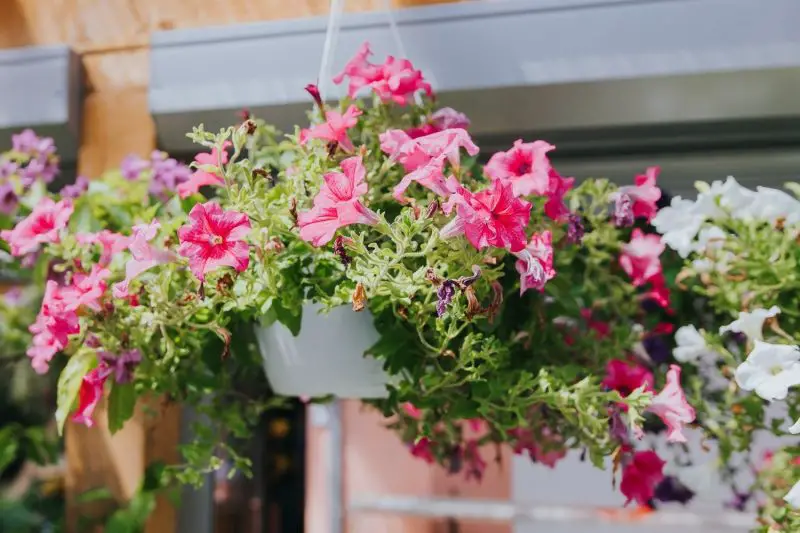Petunias are among the most vibrant and beloved flowers for hanging baskets, known for their continuous, colorful displays all summer long. However, even the healthiest petunias can slow down their blooming if not properly maintained. One of the most essential yet often overlooked practices is deadheading—the simple act of removing faded or spent blooms. While it may seem like a minor chore, deadheading plays a crucial role in keeping your hanging petunia baskets lush and full of fresh flowers. Understanding the right method can help you unlock the full blooming potential of your petunias.
In this comprehensive guide, we’ll explore exactly how to deadhead petunias in hanging baskets for more blooms. You’ll learn why this technique works, when and how to perform it, and how to maintain a flourishing display of flowers throughout the season. By the end of this article, you’ll be equipped with practical, expert-level knowledge that will turn your hanging baskets into a non-stop flower show.
Why Deadheading Petunias in Hanging Baskets Matters

Deadheading is more than just a cosmetic task—it’s a strategy rooted in plant biology. When a petunia bloom fades, the plant naturally shifts its energy toward producing seeds. This redirection of energy marks the end of the flowering process for that particular bloom, signaling to the plant that reproduction is complete. In turn, the plant slows down or even stops producing new flowers.
For gardeners who grow petunias in hanging baskets, this becomes especially important. Hanging baskets offer limited space and soil, meaning every bit of energy counts. By removing the faded blooms before seed production begins, you interrupt this cycle and send a clear message to the plant: keep blooming. This redirection of energy encourages the petunia to produce more flowers, maintaining a vibrant display for weeks on end.
Additionally, deadheading improves the overall appearance of your hanging baskets. Spent flowers can quickly turn brown or mushy, detracting from the plant’s visual appeal. Regular removal keeps your arrangements looking tidy, fresh, and well-maintained, which is particularly important when the baskets are prominently displayed in outdoor living spaces.
Understanding the Growth Habits of Petunias
To deadhead effectively, it helps to understand the basic growth habits of petunias. These plants grow vigorously in warm weather, thriving in sunny conditions and well-drained soil. They produce flowers on new growth, which means the more the plant is encouraged to branch and produce new stems, the more blooms will appear.
Petunias in hanging baskets can be classified into different types, such as grandiflora, multiflora, milliflora, and spreading (like Wave petunias). Each type may behave slightly differently in terms of bloom size and density, but all benefit from regular deadheading. For example, grandiflora varieties, which produce large blooms, tend to need more frequent maintenance than spreading types, which often self-clean more efficiently. However, even Wave petunias and other self-cleaning types benefit from occasional grooming to stay at peak performance.
By observing how your petunias grow and flower, you can tailor your deadheading technique accordingly. Paying attention to the plant’s behavior helps you time your maintenance and better support its blooming cycles.
When Is the Best Time to Deadhead Petunias?
Timing plays a vital role in successful deadheading. While there’s no strict calendar schedule, the ideal time to deadhead petunias is as soon as the flowers begin to fade and wilt. If you wait too long, the plant will already have started forming seeds, which reduces its focus on new flower production.
For most hanging baskets, checking your petunias every two to three days is a practical rhythm. This frequency ensures that you catch spent blooms early and prevents the buildup of dead or declining flowers. During peak summer months when blooming is especially vigorous, you may find it helpful to inspect your baskets daily to keep up with the fast growth and fading blooms.
It’s also beneficial to deadhead in the early morning or late afternoon. These cooler times of day reduce stress on the plant, especially during hot summer temperatures. Deadheading during midday heat can cause the plant to lose moisture more rapidly, and delicate stems may snap more easily.
How to Identify Spent Blooms on Petunias
Correctly identifying which blooms need removal is an important part of the process. A spent bloom typically shows signs of fading, wilting, or browning. The petals may lose their vibrant color and become soft or papery in texture. These flowers have completed their reproductive cycle and are no longer beneficial to the plant’s display.
Look closely at the base of the flower where it connects to the stem. If the bloom is drooping and the green calyx beneath it begins to swell or change shape, this is often a sign that the plant is beginning to develop seeds. At this point, deadheading becomes urgent to prevent the plant from shifting its focus toward seed production.
Avoid removing flowers that are still fresh and vibrant, even if they appear slightly older than others. Only faded, wilted, or discolored blooms should be pinched off, as removing healthy ones prematurely can reduce your flower count.
Step-by-Step Method to Deadhead Petunias in Hanging Baskets
The actual process of deadheading petunias in hanging baskets is quite simple, but precision makes a difference. Using your fingers or a small pair of sharp garden scissors, grasp the stem just beneath the spent flower head. Be sure to remove not just the petals, but also the base of the flower where seeds might develop.
For the cleanest cut and least damage to the plant, pinch or snip the stem just above the nearest healthy set of leaves. This encourages branching from that point, leading to fuller growth and more flowers. If you simply pull off the petals and leave the green seed pod behind, the plant may still treat it as a completed bloom and begin seed production, which defeats the purpose of deadheading.
It’s helpful to hold the hanging basket steady with one hand while working with the other, especially on windy days. Take care not to pull too hard, as petunia stems are somewhat fragile and can snap unexpectedly. With a bit of practice, you’ll develop a quick and gentle technique that becomes second nature.
Encouraging More Blooms Through Proper Care After Deadheading
Deadheading alone won’t guarantee lush petunia blooms unless it’s supported by good cultural practices. After removing faded flowers, it’s important to follow up with proper watering, feeding, and light exposure to help the plant recover and produce new buds.
Water your hanging baskets consistently, ensuring the soil stays moist but not soggy. Petunias are thirsty plants, especially in containers, and inconsistent watering can stress the roots and limit flowering. Ideally, water in the morning so foliage can dry by nightfall, reducing the risk of fungal issues.
Fertilizing regularly is also key. Petunias are heavy feeders, and hanging baskets have limited soil nutrients. Use a balanced, water-soluble fertilizer every week or two during the growing season. A formula with a slightly higher phosphorus content can promote flower production. Avoid excessive nitrogen, as it encourages leaf growth at the expense of blooms.
Lastly, ensure that your petunias are receiving adequate sunlight. These plants thrive with six to eight hours of full sun per day. If your baskets are in a shaded or partially shaded area, consider relocating them to a brighter spot to stimulate more blooms.
Should You Deadhead Self-Cleaning Petunias?
Some modern petunia varieties are labeled as “self-cleaning,” meaning they drop their old flowers without intervention. While this trait can reduce the need for frequent deadheading, it doesn’t eliminate the benefits of grooming altogether.
Wave petunias, for example, often shed their petals naturally, but the base of the bloom may remain attached and eventually form seeds if not removed. Occasional light deadheading helps prevent seed formation and keeps the plant focused on new growth. Additionally, even self-cleaning varieties can accumulate unsightly flower debris, which can be gently removed for a cleaner look.
In short, while you may not need to deadhead self-cleaning petunias as often, giving them a quick once-over every week or so ensures they stay productive and attractive throughout the season.
Rejuvenating Overgrown or Leggy Hanging Baskets
Over time, petunias in hanging baskets can become leggy or sparse, especially if deadheading has been inconsistent. If your basket starts to look overgrown with fewer blooms and long, bare stems, it may be time for a rejuvenation pruning.
Trimming back one-third of the plant can help reinvigorate growth and restore a bushier, more flower-filled shape. After pruning, feed the plant and water thoroughly to support new development. Within a week or two, you should begin to see fresh shoots and budding flowers.
This light pruning, combined with renewed deadheading, can extend the life of your hanging basket well into late summer or even early fall, depending on your growing zone.
Common Mistakes to Avoid When Deadheading Petunias
One of the most common mistakes when deadheading is removing only the petals. This leaves behind the ovary or seed pod, which still signals to the plant that reproduction is underway. Always remove the entire bloom base for best results.
Another frequent issue is waiting too long between deadheading sessions. Allowing too many spent blooms to accumulate forces the plant to shift its energy toward seed development, reducing the number of new buds. Keeping up with the task ensures continuous flowering.
Finally, avoid damaging healthy stems or buds while removing spent flowers. Be precise and gentle to avoid setting back new growth. If using scissors, ensure they’re clean and sharp to prevent bruising or tearing plant tissue.
Long-Term Benefits of Regular Deadheading
Over the course of a growing season, the cumulative benefits of deadheading are significant. Not only does this simple task encourage more blooms, but it also promotes a longer flowering period, resulting in baskets that remain visually stunning for months. The habit also creates a stronger connection between gardener and plant, allowing you to notice early signs of pests, diseases, or nutritional issues.
With regular deadheading, your petunias become more resilient, better-shaped, and fuller. Their continuous blooming adds value to outdoor spaces, attracts pollinators like bees and butterflies, and enhances the beauty of patios, porches, and garden paths.
Ultimately, deadheading is a small investment of time that yields big rewards in floral abundance.
FAQs About Deadheading Petunias in Hanging Baskets
Why do my petunias stop blooming even after deadheading?
If your petunias stop blooming, it could be due to insufficient sunlight, lack of nutrients, or irregular watering. Deadheading helps, but other growing conditions must also be optimal.
Can I deadhead petunias with my fingers instead of scissors?
Yes, you can use your fingers to gently pinch off spent blooms. Just ensure you remove the entire flower base, not just the petals, for effective results.
How often should I deadhead petunias in hanging baskets?
Deadhead your petunias every two to three days, or even daily during peak bloom periods, to keep the flowers coming and prevent seed formation.
Do all petunia varieties need to be deadheaded?
Most benefit from it, but self-cleaning varieties like Wave petunias need less frequent deadheading. Occasional grooming still improves their appearance and performance.
What time of day is best for deadheading?
The early morning or late afternoon is ideal, as the temperatures are cooler and the plants are less stressed, making it easier to handle them gently.






